Zhaozheng Yin
Beyond Words: Multimodal LLM Knows When to Speak
May 20, 2025Abstract:While large language model (LLM)-based chatbots have demonstrated strong capabilities in generating coherent and contextually relevant responses, they often struggle with understanding when to speak, particularly in delivering brief, timely reactions during ongoing conversations. This limitation arises largely from their reliance on text input, lacking the rich contextual cues in real-world human dialogue. In this work, we focus on real-time prediction of response types, with an emphasis on short, reactive utterances that depend on subtle, multimodal signals across vision, audio, and text. To support this, we introduce a new multimodal dataset constructed from real-world conversational videos, containing temporally aligned visual, auditory, and textual streams. This dataset enables fine-grained modeling of response timing in dyadic interactions. Building on this dataset, we propose MM-When2Speak, a multimodal LLM-based model that adaptively integrates visual, auditory, and textual context to predict when a response should occur, and what type of response is appropriate. Experiments show that MM-When2Speak significantly outperforms state-of-the-art unimodal and LLM-based baselines, achieving up to a 4x improvement in response timing accuracy over leading commercial LLMs. These results underscore the importance of multimodal inputs for producing timely, natural, and engaging conversational AI.
Distilling semantically aware orders for autoregressive image generation
Apr 23, 2025Abstract:Autoregressive patch-based image generation has recently shown competitive results in terms of image quality and scalability. It can also be easily integrated and scaled within Vision-Language models. Nevertheless, autoregressive models require a defined order for patch generation. While a natural order based on the dictation of the words makes sense for text generation, there is no inherent generation order that exists for image generation. Traditionally, a raster-scan order (from top-left to bottom-right) guides autoregressive image generation models. In this paper, we argue that this order is suboptimal, as it fails to respect the causality of the image content: for instance, when conditioned on a visual description of a sunset, an autoregressive model may generate clouds before the sun, even though the color of clouds should depend on the color of the sun and not the inverse. In this work, we show that first by training a model to generate patches in any-given-order, we can infer both the content and the location (order) of each patch during generation. Secondly, we use these extracted orders to finetune the any-given-order model to produce better-quality images. Through our experiments, we show on two datasets that this new generation method produces better images than the traditional raster-scan approach, with similar training costs and no extra annotations.
SemiDAViL: Semi-supervised Domain Adaptation with Vision-Language Guidance for Semantic Segmentation
Apr 08, 2025



Abstract:Domain Adaptation (DA) and Semi-supervised Learning (SSL) converge in Semi-supervised Domain Adaptation (SSDA), where the objective is to transfer knowledge from a source domain to a target domain using a combination of limited labeled target samples and abundant unlabeled target data. Although intuitive, a simple amalgamation of DA and SSL is suboptimal in semantic segmentation due to two major reasons: (1) previous methods, while able to learn good segmentation boundaries, are prone to confuse classes with similar visual appearance due to limited supervision; and (2) skewed and imbalanced training data distribution preferring source representation learning whereas impeding from exploring limited information about tailed classes. Language guidance can serve as a pivotal semantic bridge, facilitating robust class discrimination and mitigating visual ambiguities by leveraging the rich semantic relationships encoded in pre-trained language models to enhance feature representations across domains. Therefore, we propose the first language-guided SSDA setting for semantic segmentation in this work. Specifically, we harness the semantic generalization capabilities inherent in vision-language models (VLMs) to establish a synergistic framework within the SSDA paradigm. To address the inherent class-imbalance challenges in long-tailed distributions, we introduce class-balanced segmentation loss formulations that effectively regularize the learning process. Through extensive experimentation across diverse domain adaptation scenarios, our approach demonstrates substantial performance improvements over contemporary state-of-the-art (SoTA) methodologies. Code is available: \href{https://github.com/hritam-98/SemiDAViL}{GitHub}.
Enhancing Single Image to 3D Generation using Gaussian Splatting and Hybrid Diffusion Priors
Oct 12, 2024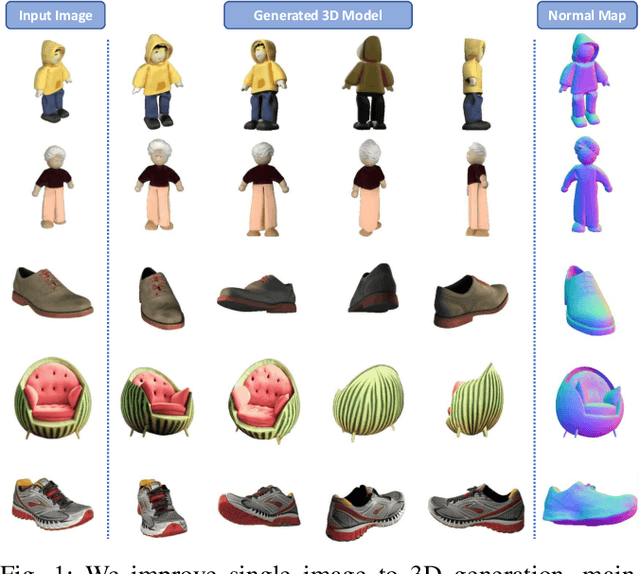
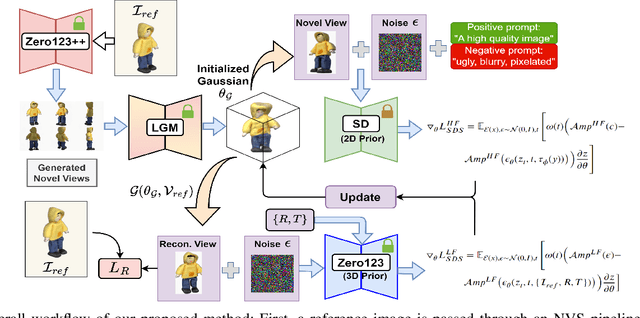
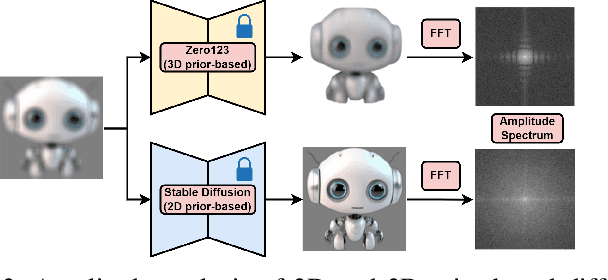
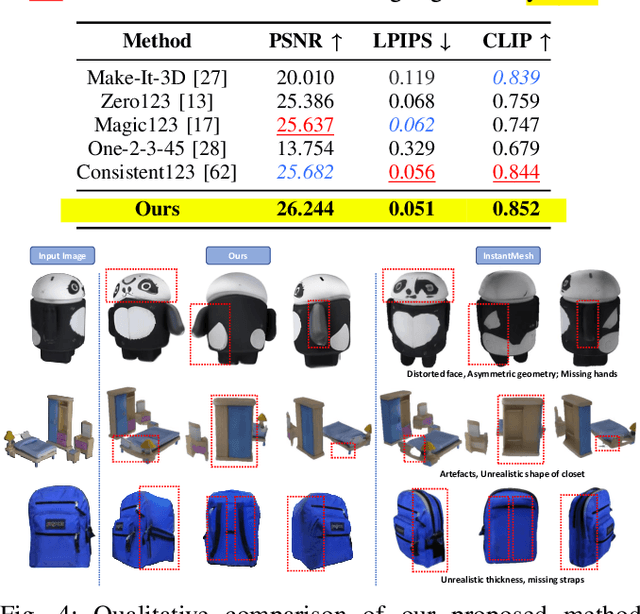
Abstract:3D object generation from a single image involves estimating the full 3D geometry and texture of unseen views from an unposed RGB image captured in the wild. Accurately reconstructing an object's complete 3D structure and texture has numerous applications in real-world scenarios, including robotic manipulation, grasping, 3D scene understanding, and AR/VR. Recent advancements in 3D object generation have introduced techniques that reconstruct an object's 3D shape and texture by optimizing the efficient representation of Gaussian Splatting, guided by pre-trained 2D or 3D diffusion models. However, a notable disparity exists between the training datasets of these models, leading to distinct differences in their outputs. While 2D models generate highly detailed visuals, they lack cross-view consistency in geometry and texture. In contrast, 3D models ensure consistency across different views but often result in overly smooth textures. We propose bridging the gap between 2D and 3D diffusion models to address this limitation by integrating a two-stage frequency-based distillation loss with Gaussian Splatting. Specifically, we leverage geometric priors in the low-frequency spectrum from a 3D diffusion model to maintain consistent geometry and use a 2D diffusion model to refine the fidelity and texture in the high-frequency spectrum of the generated 3D structure, resulting in more detailed and fine-grained outcomes. Our approach enhances geometric consistency and visual quality, outperforming the current SOTA. Additionally, we demonstrate the easy adaptability of our method for efficient object pose estimation and tracking.
CUPre: Cross-domain Unsupervised Pre-training for Few-Shot Cell Segmentation
Oct 06, 2023



Abstract:While pre-training on object detection tasks, such as Common Objects in Contexts (COCO) [1], could significantly boost the performance of cell segmentation, it still consumes on massive fine-annotated cell images [2] with bounding boxes, masks, and cell types for every cell in every image, to fine-tune the pre-trained model. To lower the cost of annotation, this work considers the problem of pre-training DNN models for few-shot cell segmentation, where massive unlabeled cell images are available but only a small proportion is annotated. Hereby, we propose Cross-domain Unsupervised Pre-training, namely CUPre, transferring the capability of object detection and instance segmentation for common visual objects (learned from COCO) to the visual domain of cells using unlabeled images. Given a standard COCO pre-trained network with backbone, neck, and head modules, CUPre adopts an alternate multi-task pre-training (AMT2) procedure with two sub-tasks -- in every iteration of pre-training, AMT2 first trains the backbone with cell images from multiple cell datasets via unsupervised momentum contrastive learning (MoCo) [3], and then trains the whole model with vanilla COCO datasets via instance segmentation. After pre-training, CUPre fine-tunes the whole model on the cell segmentation task using a few annotated images. We carry out extensive experiments to evaluate CUPre using LIVECell [2] and BBBC038 [4] datasets in few-shot instance segmentation settings. The experiment shows that CUPre can outperform existing pre-training methods, achieving the highest average precision (AP) for few-shot cell segmentation and detection.
Advancements in Repetitive Action Counting: Joint-Based PoseRAC Model With Improved Performance
Aug 15, 2023



Abstract:Repetitive counting (RepCount) is critical in various applications, such as fitness tracking and rehabilitation. Previous methods have relied on the estimation of red-green-and-blue (RGB) frames and body pose landmarks to identify the number of action repetitions, but these methods suffer from a number of issues, including the inability to stably handle changes in camera viewpoints, over-counting, under-counting, difficulty in distinguishing between sub-actions, inaccuracy in recognizing salient poses, etc. In this paper, based on the work done by [1], we integrate joint angles with body pose landmarks to address these challenges and achieve better results than the state-of-the-art RepCount methods, with a Mean Absolute Error (MAE) of 0.211 and an Off-By-One (OBO) counting accuracy of 0.599 on the RepCount data set [2]. Comprehensive experimental results demonstrate the effectiveness and robustness of our method.
ACF-Net: An Attention-enhanced Co-interactive Fusion Network for Automated Structural Condition Assessment in Visual Inspection
Jul 14, 2023Abstract:Efficiently monitoring the condition of civil infrastructures necessitates automating the structural condition assessment in visual inspection. This paper proposes an Attention-enhanced Co-interactive Fusion Network (ACF-Net) for automatic structural condition assessment in visual bridge inspection. The ACF-Net can simultaneously parse structural elements and segment surface defects on the elements in inspection images. It integrates two task-specific relearning subnets to extract task-specific features from an overall feature embedding and a co-interactive feature fusion module to capture the spatial correlation and facilitate information sharing between tasks. Experimental results demonstrate that the proposed ACF-Net outperforms the current state-of-the-art approaches, achieving promising performance with 92.11% mIoU for element parsing and 87.16% mIoU for corrosion segmentation on the new benchmark dataset Steel Bridge Condition Inspection Visual (SBCIV) testing set. An ablation study reveals the strengths of ACF-Net, and a case study showcases its capability to automate structural condition assessment. The code will be open-source after acceptance.
Semi-supervised Domain Adaptive Medical Image Segmentation through Consistency Regularized Disentangled Contrastive Learning
Jul 06, 2023Abstract:Although unsupervised domain adaptation (UDA) is a promising direction to alleviate domain shift, they fall short of their supervised counterparts. In this work, we investigate relatively less explored semi-supervised domain adaptation (SSDA) for medical image segmentation, where access to a few labeled target samples can improve the adaptation performance substantially. Specifically, we propose a two-stage training process. First, an encoder is pre-trained in a self-learning paradigm using a novel domain-content disentangled contrastive learning (CL) along with a pixel-level feature consistency constraint. The proposed CL enforces the encoder to learn discriminative content-specific but domain-invariant semantics on a global scale from the source and target images, whereas consistency regularization enforces the mining of local pixel-level information by maintaining spatial sensitivity. This pre-trained encoder, along with a decoder, is further fine-tuned for the downstream task, (i.e. pixel-level segmentation) using a semi-supervised setting. Furthermore, we experimentally validate that our proposed method can easily be extended for UDA settings, adding to the superiority of the proposed strategy. Upon evaluation on two domain adaptive image segmentation tasks, our proposed method outperforms the SoTA methods, both in SSDA and UDA settings. Code is available at https://github.com/hritam-98/GFDA-disentangled
Cross-domain Microscopy Cell Counting by Disentangled Transfer Learning
Nov 26, 2022Abstract:Microscopy cell images of biological experiments on different tissues/organs/imaging conditions usually contain cells with various shapes and appearances on different image backgrounds, making a cell counting model trained in a source domain hard to be transferred to a new target domain. Thus, costly manual annotation is required to train deep learning-based cell counting models across different domains. Instead, we propose a cross-domain cell counting approach with only a little human annotation effort. First, we design a cell counting network that can disentangle domain-specific knowledge and domain-agnostic knowledge in cell images, which are related to the generation of domain style images and cell density maps, respectively. Secondly, we propose an image synthesis method capable of synthesizing a large number of images based on a few annotated ones. Finally, we use a public dataset of synthetic cells, which has no annotation cost at all as the source domain to train our cell counting network; then, only the domain-agnostic knowledge in the trained model is transferred to a new target domain of real cell images, by progressively fine-tuning the trained model using synthesized target-domain images and a few annotated ones. Evaluated on two public target datasets of real cell images, our cross-domain cell counting approach that only needs annotation on a few images in a new target domain achieves good performance, compared to state-of-the-art methods that rely on fully annotated training images in the target domain.
An Attention-guided Multistream Feature Fusion Network for Localization of Risky Objects in Driving Videos
Sep 16, 2022
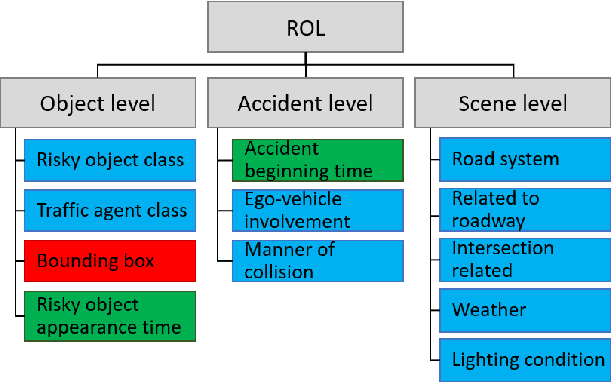
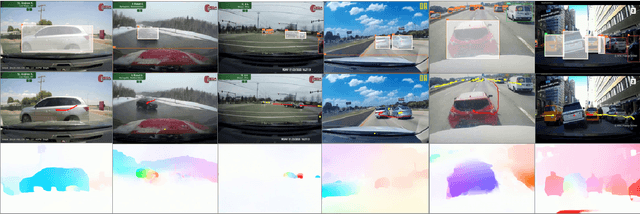
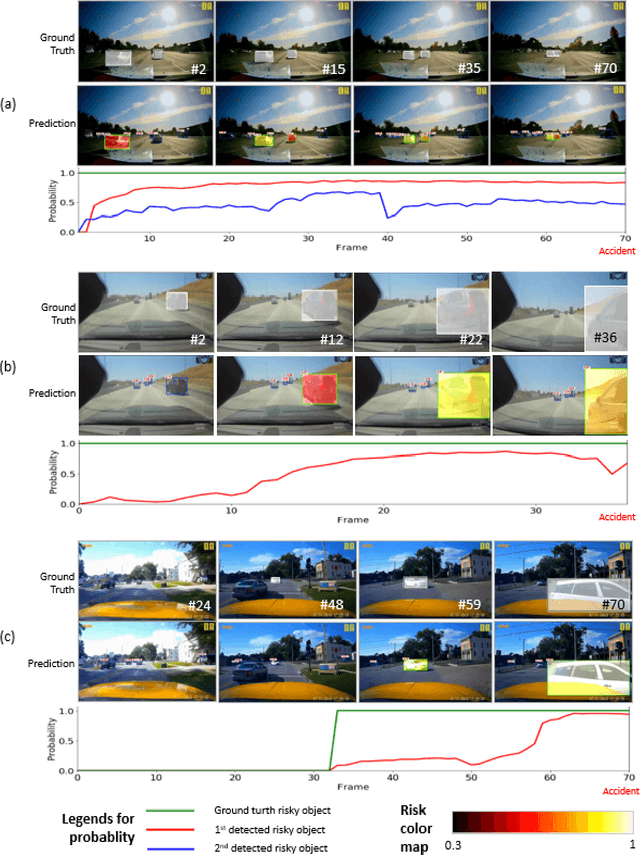
Abstract:Detecting dangerous traffic agents in videos captured by vehicle-mounted dashboard cameras (dashcams) is essential to facilitate safe navigation in a complex environment. Accident-related videos are just a minor portion of the driving video big data, and the transient pre-accident processes are highly dynamic and complex. Besides, risky and non-risky traffic agents can be similar in their appearance. These make risky object localization in the driving video particularly challenging. To this end, this paper proposes an attention-guided multistream feature fusion network (AM-Net) to localize dangerous traffic agents from dashcam videos. Two Gated Recurrent Unit (GRU) networks use object bounding box and optical flow features extracted from consecutive video frames to capture spatio-temporal cues for distinguishing dangerous traffic agents. An attention module coupled with the GRUs learns to attend to the traffic agents relevant to an accident. Fusing the two streams of features, AM-Net predicts the riskiness scores of traffic agents in the video. In supporting this study, the paper also introduces a benchmark dataset called Risky Object Localization (ROL). The dataset contains spatial, temporal, and categorical annotations with the accident, object, and scene-level attributes. The proposed AM-Net achieves a promising performance of 85.73% AUC on the ROL dataset. Meanwhile, the AM-Net outperforms current state-of-the-art for video anomaly detection by 6.3% AUC on the DoTA dataset. A thorough ablation study further reveals AM-Net's merits by evaluating the contributions of its different components.
 Add to Chrome
Add to Chrome Add to Firefox
Add to Firefox Add to Edge
Add to Edge